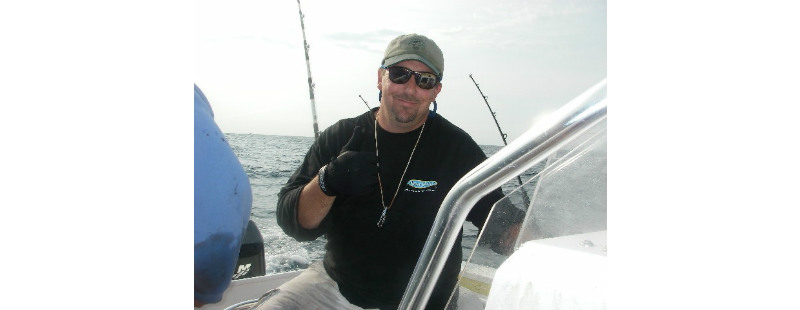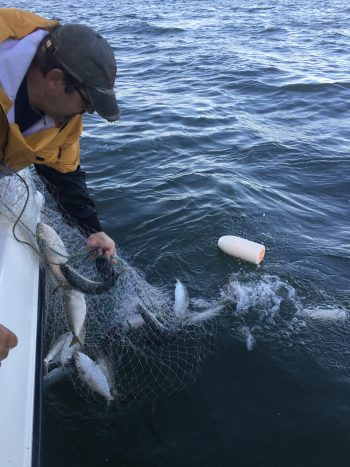I don’t remember the first time I went to a menhaden hearing, but I sure do remember the first time I saw menhaden in person. It was the 1970s and I was fishing from the Castle Island Pier in South Boston. Boston Harbor was still one of the dirtiest bodies of water in the country, but the scene in front of me was something out of National Geographic magazine. I remember the school as being massive, and the crashing and slashing of extra large bluefish devastating these important baitfish has stayed with me my whole life. I also vividly remember how years after the decade plus clean up of Boston Harbor, the menhaden seemed to be going away. The cleaner our water the less bluefish and striped bass were available. That’s not how it was supposed to work.
It got so bad in the early 2000s that my partner and I would win dozens of fishing tournaments simply because we were willing to spend more than 6 hours tending two separate hundred foot floating gill nets just to get between one and two dozen of these precious live baits. Needless to say, my becoming an advocate for sustainable menhaden stocks was natural.
To understand how bizarre fisheries hearings can be, I once was in an Atlantic States Marine Fisheries Commission (ASMFC) public hearing where multiple $400 per hour Washington, DC-based lawyers testified that the reason Boston Harbor had no bunker was because the water was too clean. Thankfully the resolve of recreational anglers kept the fight going for many years. In 2012 a true coalition of recreational, small boat commercial and environmental organizations came together and forced conservation into menhaden management. Today, menhaden stocks are increasing annually and are reclaiming their historic range not only in Massachusetts, but also in 2016 the comeback began to reach into Maine state waters.
The Menhaden Management Board of the ASMFC has now initiated the next chapter in menhaden management. Amendment 3 to the menhaden management plan will establish ecological management, and review state-by-state quota allocations. At their annual meeting in October 2016, ASMFC’s Menhaden Management Board unanimously approved the Public Information Document (PID) for Draft Amendment 3 for public comment. The public can comment at upcoming hearings or in writing before January 4, 2017. The PID, which precedes a draft of the actual amendment, provides the first opportunity for stakeholders to inform the Board about their own visions for the future of menhaden management.
I must share credit and thank the loosely organized group of men and women who identify ourselves as the Menhaden Coalition. This group of tireless advocates share ideas and challenge each other in order for each of us to better represent our communities as best we can. The following is a point-by-point editorial on the 9 issues that will make up the bulk of the hearings ongoing throughout the month. Although born out of Menhaden Coalition discussions, the following are my opinions as a conservation-minded angler from Massachusetts who is lucky enough to make a living within the community of fishing advocates.
ISSUE 1: Reference Points
PID Questions: Should the Board manage the Atlantic menhaden stock with single-species biological reference points or multi-species ecological reference points (ERPs)? Do you support the use of simpler, readily available ERPs until menhaden-specific ERPs are developed?
Opinion: The Board should start to manage menhaden using ecological reference points with whatever models are available today. With abundance of menhaden rising and the geographic range growing, the time to switch from “single species” to “ecological” based management is now.
Issue 1, Option D is the best solution available today. Managing menhaden at 75% of the pre-industrial fishing stock size and requiring that the population never drops below 40 percent will allow sustainable harvest and help menhaden continue to expand back into the northern and southern extents of their range. Conservation will benefit everyone. Option D will enable the menhaden population to continue to grow, increasing value to recreational fishing, commercial seafood, and tourism businesses that all depend on this important fish.
ISSUE 2: Quota Allocation
PID Questions: Should the Board maintain, or revise, the allocation formula currently used to manage the commercial Atlantic menhaden fishery? Which allocation option(s) provides for the fairest and most equitable distribution of coast wide total allowable catch? Which allocation option(s) strikes the best balance between current needs and future growth opportunities? Do you support the use of soft quotas for some user groups?
Opinion: The Board should change the current allocation. One state taking 85% of the catch is inequitable and seems to contradict recent NOAA guidance on allocation.
Three options have the most potential to provide a fair and equitable distribution of catch. Options B, F, G strike the best balance between current needs and future growth:
- Option B: State-specific quotas with a fixed minimum
- Option F: Disposition quotas with at least 30% of catch allocated to the bait sector
- Option G: Fleet capacity quotas, with all fleets managed by a hard quota.
Three options should be removed from Amendment 3:
“Soft” quotas are too complicated and risk quota overages. They should not be allowed in Amendment 3.
ISSUE 3: Allocation Timeframe
PID Questions: Should the Board consider changes to the reference period on which menhaden allocation is based? Should allocation consider prior trends as well as recent changes in the fishery? What years would you recommend as the basis for allocation?
Opinion: By considering only 2009-2011 or 2012-2016, the Board is unfairly excluding the significant catch history of other states, especially in the Northeast where the last assessment shows processing plants existed until the 1980s. Catch data from as early as 1955 should be considered. In this section Option D (2012-2016) should be removed from the Amendment, as it is simply reflects the status quo option.
ISSUE 4: Quota Transfers and Overage Payback
Questions: Should the process for quota transfers be further defined or replaced by an automatic reconciliation process? Should state specific quota overages be forgiven in years when the coastwide TAC is not exceeded? When the coastwide TAC is exceeded but at least one jurisdiction has an underage, should unused quota be pooled and redistributed through a specified transfer process to states with an overage? Should states be required to contribute unused quota to a common pool or should this be voluntary? Should there be accountability measures for a state that exceeds its quota by a certain percentage or repeatedly participates in quota reconciliation?
Opinion: Quota transfers should be unrestricted only if completed prior to a state exceeding its quota. A state receiving a quota transfer after exceeding its quota should be required to take action to avoid the overage in the following year and should not be allowed to accept a quota overage transfer in the following year.
ISSUE 5: Quota Rollovers
Questions: Should unused quota be rolled over into subsequent year? Should the amount rolled over be limited to a percentage of quota? Should all sectors of the fishery be allowed to roll over quota? Should rollover be mandatory or voluntary?
Opinion: Quota rollovers should not be allowed in a fishery where transfer of quota is allowed. Rollovers may lead to unintended consequences with regard to localized depletion.
ISSUE 6: Incidental Catch and Small Scale Fishery Allowance
Question: Should there be a cap on incidental landings in the Atlantic menhaden fishery? Should incidental catch be defined as a percent composition? Should the incidental catch allowance be allocated to vessels or permit holders? Should the incidental catch provision be replaced with a small-scale fishery set aside, and if yes, what gears should be included in this sub-quota (see Table 3 in Appendix 1)? Should active and passive gears be treated differently under the incidental catch provision?
Opinion: The current bycatch allowance is actually a loophole created to protect some small pound net harvesters who needed protection. Unfortunately, as written, this regulation allows several million pounds of menhaden to be caught, but not counted toward the quota. The problems this exemption was created to address should be eliminated under an updated allocation scheme. This section should be eliminated from the management plan and, above all else, all harvest must be counted.
ISSUE 7: Episodic Events Set Aside
Questions: Should a percentage of the TAC be set aside for episodic events? If yes, what percentage of the annual TAC should be set aside? Which jurisdictions should be allowed to participate in this program? Does the episodic event program need to be reconsidered as the distribution of menhaden changes? How should states demonstrate that an episodic event is occurring in state waters?
Opinion: The episodic events set aside is unnecessary. A fair allocation and a quota transfer process that includes accountability is enough flexibility to manage expected fluctuations in local abundance of a sustainable fishery.
ISSUE 8: Chesapeake Bay Reduction Fishery Cap
Questions: Should the Chesapeake Bay Reduction Fishery Cap be maintained? Is it an important tool for the management of Atlantic menhaden?
Opinion: The Bay remains the primary nursery for the coast wide menhaden population, and the area where the majority of catch is concentrated. The cap should be kept in Amendment 3, but reduced to 96 million pounds (closer to current levels) to protect against localized depletion and provide for the many predators that depend on menhaden in the Bay.
ISSUE 9: Research Programs and Priorities
Questions: What are important research questions that need to be answered regarding the menhaden fishery and resource? How should research recommendations be prioritized? Should there be some quota held as a Research Set Aside to fund research specific to menhaden? If yes, what portion of TAC should be set aside for research purposes?
Opinion: The ASMFC should prioritize fishery independent research on the following subjects: how to avoid localized fish kills in an abundant fishery, effects of localized depletion, and food web interactions of menhaden.
I understand some of these questions will seem a bit “wonky” to people who simply desire a healthy ecosystem and reasonable commercial and recreational fisheries. Unfortunately, comment periods like this are how the public gets their say on how our shared natural resources are managed. If you want to chime in but find one or two of the questions overly complicated, then simply write comments on how you feel. Write what you think. The only thing that makes this process fail is a lack of participation. Please consider making a comment. Your voice matters.





